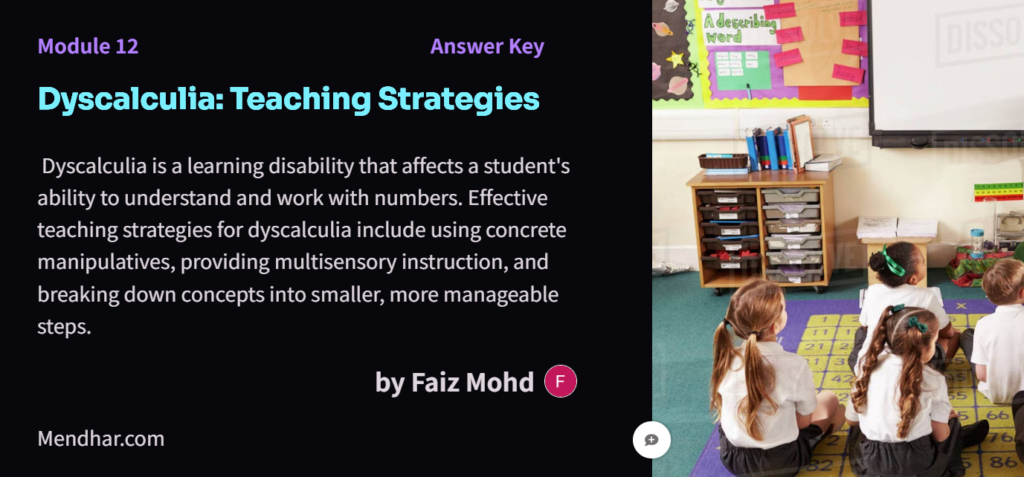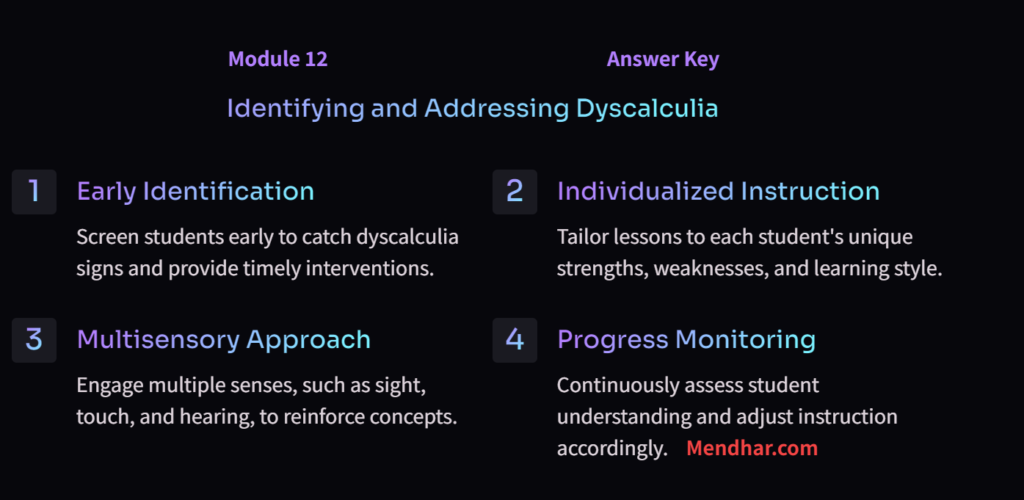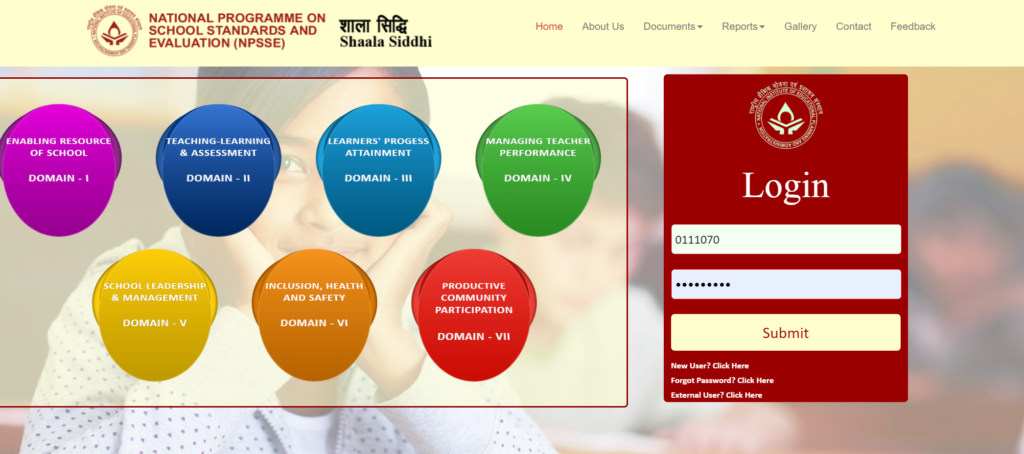Table of Contents
ToggleIntroduction to Dyscalculia: Teaching Strategies-Module 12

Teaching strategies for dyscalculia, a learning disorder that affects a person’s ability to understand numbers and learn math skills, should be tailored to the individual’s needs and strengths. Here are some effective approaches:
Multisensory Learning: Engage multiple senses like sight, touch, and hearing to reinforce concepts. Use manipulatives such as blocks, beads, or counters to represent numbers and operations.
Visual Aids: Utilize visual aids like diagrams, charts, and graphs to illustrate mathematical concepts. Color-coding and highlighting can also help organize information and make it easier to understand.
Chunking: Break down complex problems into smaller, more manageable parts. Teach students to focus on one step at a time and gradually build up to solving the entire problem.
Real-World Applications: Connect math to real-life situations to make it more meaningful and relevant. For example, use everyday activities like shopping, cooking, or budgeting to demonstrate how math is used in daily life.
Use of Technology: Incorporate educational apps, computer programs, or specialized software designed for dyscalculia. These tools can provide additional practice, immediate feedback, and personalized learning experiences.
Repeated Practice and Review: Offer ample opportunities for practice and review to reinforce learning. Provide feedback and encouragement to build confidence and motivation.
Explicit Instruction: Clearly explain mathematical concepts step by step, using simple language and concrete examples. Avoid using abstract or ambiguous language that may confuse students.
Flexible Instructional Strategies: Be flexible in your teaching approach and be willing to modify instruction based on individual needs. Differentiate instruction to accommodate diverse learning styles and abilities.
Positive Reinforcement: Provide praise and positive reinforcement to encourage effort and progress. Celebrate small achievements and milestones along the way.
Collaboration and Support: Collaborate with parents, caregivers, and other professionals to provide comprehensive support. Work together to identify strategies that work best for the individual student and create a supportive learning environment.Dyscalculia: Teaching Strategies-Module 12 Answer key is a blog composed to get the answer key.

Dyscalculia: Teaching Strategies-Module 12 Answer key
1. Highlighting and focusing on the key terms of the concept will be disadvantageous for the child.
– True (False)
– Explanation: False. Highlighting and focusing on the key terms of a concept can be advantageous for a child’s learning. By emphasizing key terms, students can better understand the main ideas and important details of the concept being taught. This approach helps improve comprehension, retention, and the ability to apply knowledge.
2. Mnemonic instructions are a set of strategies designed to help students improve their memory for new information.
– True (True)
– Explanation: True. Mnemonic instructions are indeed a set of strategies designed to help students improve their memory for new information. Mnemonics involve using techniques such as acronyms, rhymes, visual imagery, or chunking to aid in the retention and recall of information. These strategies can be particularly helpful for students with learning difficulties or those who struggle with memory retention.
3. In the Multi-Sensory Approach, we need to pass the input through different modalities such as auditory inputs, visual inputs, tactile inputs and so on.
– True (True)
– Explanation: True. In the Multi-Sensory Approach, input is indeed passed through different modalities such as auditory, visual, and tactile inputs. This approach aims to engage multiple senses simultaneously to enhance learning and retention. By incorporating various sensory modalities, educators can accommodate different learning styles and provide multiple pathways for students to access and process information.
4. Through the tactile modality, the child can be asked to touch and move objects one by one and count.
– True (True)
– Explanation: True. Through the tactile modality, the child can indeed be asked to touch and move objects one by one and count. Tactile learning involves hands-on experiences and physical interactions with objects to understand and learn concepts. By physically manipulating objects, students can develop a deeper understanding of mathematical concepts such as counting, sorting, and grouping.
5. The Play-way method is an activity-based learning that enables overall development of the child in terms of feelings, intellect, and skills.
– True (True)
– Explanation: True. The Play-way method is indeed an activity-based learning approach that enables the overall development of the child in terms of feelings, intellect, and skills. This method emphasizes learning through play, exploration, and hands-on experiences, allowing children to develop social, emotional, cognitive, and physical skills in a holistic manner.
Dyscalculia: Teaching Strategies-Module 12 Answer key
6. Listening to others and describing their methods can help children try and break down their own methods while solving questions in Mathematics.
– True (True)
– Explanation: True. Listening to others and describing their methods can indeed help children try and break down their own methods while solving questions in Mathematics. By engaging in discussions and sharing problem-solving strategies with peers, students have the opportunity to gain new insights, learn alternative approaches, and reflect on their own thinking processes. This collaborative learning process promotes critical thinking, metacognition, and a deeper understanding of mathematical concepts.
7. Dyscalculia is a type of Specific Learning Disability (SLD) that deeply affects learning related to mathematics.
– True (True)
– Explanation: True. Dyscalculia is indeed a type of Specific Learning Disability (SLD) that deeply affects learning related to mathematics. Individuals with dyscalculia may struggle with various aspects of mathematical reasoning, computation, and understanding numerical concepts. This learning disability can manifest in difficulties with basic arithmetic operations, number sense, mathematical reasoning, and the ability to understand and apply mathematical concepts.
8. Dyslexia is a language-based learning disability.
– True (True)
– Explanation: True. Dyslexia is indeed a language-based learning disability. It primarily affects reading and related language-based processing skills, making it difficult for individuals to accurately interpret and process written or spoken language. While dyslexia primarily impacts language processing, it can also affect other areas such as reading comprehension, spelling, and writing.
9. Dyscalculia is a type of Specific Learning Disability (SLD) that affects learning related to mathematics by making it difficult for individuals to understand mathematical concepts and perform calculations.
– True (True)
– Explanation: True. Dyscalculia is indeed a type of Specific Learning Disability (SLD) that affects learning related to mathematics by making it difficult for individuals to understand mathematical concepts and perform calculations. Individuals with dyscalculia may struggle with basic arithmetic operations, number sense, mathematical reasoning, and the ability to apply mathematical concepts in real-world situations.
10. The Concrete-Representational-Abstract (CRA) approach of teaching involves math intervention at three levels: concrete, pictorial, and abstract.
– True (True)
– Explanation: True. The Concrete-Representational-Abstract (CRA) approach of teaching indeed involves math intervention at three levels: concrete, pictorial, and abstract. This approach emphasizes a progression from using physical objects or manipulatives (concrete) to representing concepts with pictures or diagrams (pictorial) and finally transitioning to symbolic representation using numbers and symbols (abstract). This sequential approach helps students build a deep understanding of mathematical concepts by gradually transitioning from concrete experiences to more abstract reasoning.
Dyscalculia: Teaching Strategies-Module 12 Answer key
11. Subitising is
a skill of instantly recognizing quantity with little or no counting at all.
– True (True)
– Explanation: True. Subitising is indeed a skill of instantly recognizing quantity with little or no counting at all. It involves the ability to perceive the number of objects in a group without the need for counting individually. This skill is often developed through practice and exposure to various patterns and arrangements of objects. Subitising is considered an important foundational skill in mathematics, as it supports the development of number sense and arithmetic fluency.
12. Dyslexia is a type of Specific Learning Disability (SLD) that primarily affects reading and related language-based processing skills.
– True (True)
– Explanation: True. Dyslexia is indeed a type of Specific Learning Disability (SLD) that primarily affects reading and related language-based processing skills. Individuals with dyslexia may have difficulties with accurate and fluent word recognition, spelling, and decoding abilities. This learning disability can impact reading comprehension, writing, and other aspects of language processing, but it does not necessarily affect intelligence or overall cognitive abilities.
13. Peer Buddy System is when students with Dyslexia are paired with their peers in the class to provide support in reading and writing skills.
– True (True)
– Explanation: True. Peer Buddy System is indeed when students with Dyslexia are paired with their peers in the class to provide support in reading and writing skills. This approach fosters collaboration, peer support, and social interaction among students with and without learning disabilities. Peers can provide encouragement, assistance, and positive reinforcement, which can enhance the learning experience for students with Dyslexia and promote inclusion in the classroom.
14. The KWL method helps improve reading comprehension of the child and also helps them remember the topic and do the question answers well.
– True (False)
– Explanation: False. The KWL method does not necessarily improve reading comprehension or help with remembering the topic and answering questions well. The KWL method stands for “Know, Want to know, Learn”. It is a pre-reading strategy that helps students activate their prior knowledge, set goals for learning, and monitor their understanding as they read. While the KWL method can be useful for activating prior knowledge and promoting engagement, its effectiveness in improving reading comprehension may vary depending on other factors such as instructional context and student characteristics.
15. Dyscalculia is a type of Specific Learning Disability (SLD) that primarily affects reading and related language-based processing skills.
– True (False)
– Explanation: False. Dyscalculia is not primarily associated with reading and related language-based processing skills. Instead, Dyscalculia is a type of Specific Learning Disability (SLD) that affects learning related to mathematics. Individuals with Dyscalculia may struggle with various aspects of mathematical reasoning, computation, and understanding numerical concepts. This learning disability can manifest in difficulties with basic arithmetic operations, number sense, mathematical reasoning, and the ability to understand and apply mathematical concepts.



Pingback: Dysgraphia: Teaching Strategies-Module 13 -
Pingback: Multiple Disabilities: Teaching Strategies-Module 14 -